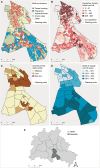Exploration of the COVID-19 pandemic at the neighborhood level in an intra-urban setting
- PMID: 37124802
- PMCID: PMC10133460
- DOI: 10.3389/fpubh.2023.1128452
Exploration of the COVID-19 pandemic at the neighborhood level in an intra-urban setting
Abstract
The COVID-19 pandemic represents a worldwide threat to health. Since its onset in 2019, the pandemic has proceeded in different phases, which have been shaped by a complex set of influencing factors, including public health and social measures, the emergence of new virus variants, and seasonality. Understanding the development of COVID-19 incidence and its spatiotemporal patterns at a neighborhood level is crucial for local health authorities to identify high-risk areas and develop tailored mitigation strategies. However, analyses at the neighborhood level are scarce and mostly limited to specific phases of the pandemic. The aim of this study was to explore the development of COVID-19 incidence and spatiotemporal patterns of incidence at a neighborhood scale in an intra-urban setting over several pandemic phases (March 2020-December 2021). We used reported COVID-19 case data from the health department of the district Berlin-Neukölln, Germany, additional socio-demographic data, and text documents and materials on implemented public health and social measures. We examined incidence over time in the context of the measures and other influencing factors, with a particular focus on age groups. We used incidence maps and spatial scan statistics to reveal changing spatiotemporal patterns. Our results show that several factors may have influenced the development of COVID-19 incidence. In particular, the far-reaching measures for contact reduction showed a substantial impact on incidence in Neukölln. We observed several age group-specific effects: school closures had an effect on incidence in the younger population (< 18 years), whereas the start of the vaccination campaign had an impact primarily on incidence among the elderly (> 65 years). The spatial analysis revealed that high-risk areas were heterogeneously distributed across the district. The location of high-risk areas also changed across the pandemic phases. In this study, existing intra-urban studies were supplemented by our investigation of the course of the pandemic and the underlying processes at a small scale over a long period of time. Our findings provide new insights for public health authorities, community planners, and policymakers about the spatiotemporal development of the COVID-19 pandemic at the neighborhood level. These insights are crucial for guiding decision-makers in implementing mitigation strategies.
Keywords: COVID-19; age groups; public health measure; spatial scan statistics; spatiotemporal analysis; urban health.
Copyright © 2023 Schmitz, Lakes, Manafa, Lambio, Butler, Roth and Savaskan.
Conflict of interest statement
The authors declare that the research was conducted in the absence of any commercial or financial relationships that could be construed as a potential conflict of interest.
Figures




Similar articles
-
Epidemiology of COVID-19 in Berlin-Neukölln nursing homes.J Infect Public Health. 2024 Nov;17(11):102546. doi: 10.1016/j.jiph.2024.102546. Epub 2024 Sep 20. J Infect Public Health. 2024. PMID: 39321605
-
The need for holistic, longitudinal and comparable, real-time assessment of the emotional, behavioral and societal impact of the COVID-19 pandemic across nations.Psychiatriki. 2021 Apr 19;32(1):15-18. doi: 10.22365/jpsych.2021.010. Epub 2021 Mar 8. Psychiatriki. 2021. PMID: 33759804 English, Greek, Modern.
-
Census Tract Patterns and Contextual Social Determinants of Health Associated With COVID-19 in a Hispanic Population From South Texas: A Spatiotemporal Perspective.JMIR Public Health Surveill. 2021 Aug 5;7(8):e29205. doi: 10.2196/29205. JMIR Public Health Surveill. 2021. PMID: 34081608 Free PMC article.
-
Early Adolescents' Experiences During the COVID-19 Pandemic and Changes in Their Well-Being.Front Public Health. 2022 May 3;10:823303. doi: 10.3389/fpubh.2022.823303. eCollection 2022. Front Public Health. 2022. PMID: 35592082 Free PMC article. Review.
-
Systematic Review of Clinical Insights into Novel Coronavirus (CoVID-19) Pandemic: Persisting Challenges in U.S. Rural Population.Int J Environ Res Public Health. 2020 Jun 15;17(12):4279. doi: 10.3390/ijerph17124279. Int J Environ Res Public Health. 2020. PMID: 32549334 Free PMC article.
Cited by
-
Pathogenic built environment? Reflections on modeling spatial determinants of health in urban settings considering the example of COVID-19 studies.Front Public Health. 2025 Mar 17;13:1502897. doi: 10.3389/fpubh.2025.1502897. eCollection 2025. Front Public Health. 2025. PMID: 40165988 Free PMC article.
-
The impact of urban spatial environment on COVID-19: a case study in Beijing.Front Public Health. 2024 Jan 8;11:1287999. doi: 10.3389/fpubh.2023.1287999. eCollection 2023. Front Public Health. 2024. PMID: 38259769 Free PMC article.
References
-
- World Health Organisation (WHO) . WHO Coronavirus (COVID-19) Dashboard. Geneva: WHO; (2022).
-
- Talic S, Shah S, Wild H, Gasevic D, Maharaj A, Ademi Z, et al. . Effectiveness of public health measures in reducing the incidence of covid-19, SARS-CoV-2 transmission, and covid-19 mortality: systematic review and meta-analysis. BMJ. (2021) 375:e068302. doi: 10.1136/bmj-2021-068302, PMID: - DOI - PMC - PubMed
-
- Nicolay N, Innocenti F, Beaute J, Ucakar V, Vitek MG, Poukka E, et al. . Initial assessment of the COVID-19 vaccination’s impact on case numbers, hospitalisations and deaths in people aged 80 years and older, 15 EU/EEA countries, December 2020 to may 2021. Eur Secur. (2021) 26:1–8. doi: 10.2807/1560-7917.ES.2021.26.48.2101030, PMID: - DOI - PMC - PubMed
Publication types
MeSH terms
LinkOut - more resources
Full Text Sources
Medical

